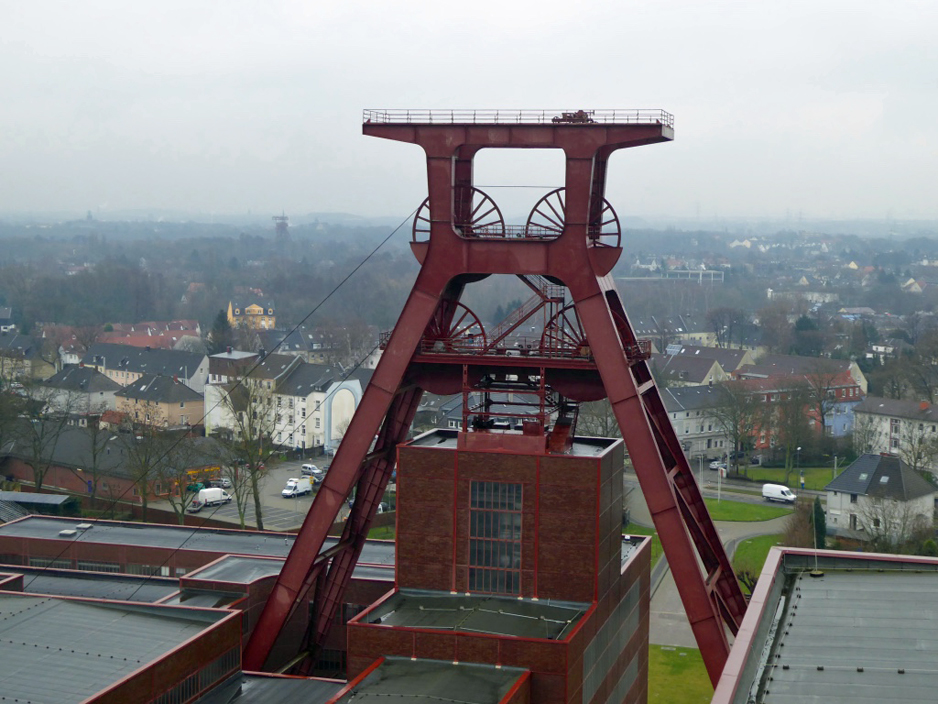
It might seem strange to write about a museum in a football blog.
I believe, however, that if you want to understand German football you need to know about where it came from.
The region of Germany bordered by the rivers Rhine, Ruhr and Lippe – the Ruhrgebiet – has had a huge impact on Germany’s history and its football. The mines of the Ruhrgebiet provided the coal that powered Germany’s industrial revolution. Its foundries produced the steel that was used to build the factories and machines. Its rivers and canals carried Germany’s products far and wide. Its people became know across the country for their toughness and capacity for hard work, and for their solidarity and strong sense of community.
For most of the last century the Ruhrgebiet was also the epicentre of German football. Just like in the North East of England, or the central belt of Scotland, they said that all you had to do was whistle down a pit to call up yet another outstanding footballer. Clubs from the Ruhrgebiet and its close neighbours totally dominated the game. Their players were the nucleus of the national teams of the day. Even today this corner of Germany continues to churn out top class players – Mezut Ozil, Manuel Neuer and Marco Reuss are just three very recent examples – and its football clubs continue to be massively important. Schalke 04 and BvB Dortmund are two of the biggest, most passionately followed football clubs in the world. Clubs with long and proud traditions like VfL Bochum, Rot Weiss Essen, MSV Duisburg and SG Wattenscheidt continue to attract thousands of super-loyal fans. Football is still a vital part of the Ruhrgebiet, and Ruhrgebiet football is a vital part of the national game.
That’s why I recently took the 101 tram through the rainswept suburbs of Essen to the Ruhr Museum. I wanted to find out more about the people of this region and to better understand their history and culture
The history of a region
Based at the former Zollverein Coal Mine, it covers the natural, political, cultural and industrial history of the Ruhr region from the formation of coal deposits over 300 million years ago right up to the present day.
It shows how this quiet rural backwater was transformed in a few decades into the largest industrial area in Europe, endured the cataclysmic consequences of two world wars, powered the German economic miracle of the 1950s and survived post-industrial economic re-structuring to become the modern metropolis we know today.
The perfect site
The setting is perfect. The Zollverein was one of Europe’s biggest mines, with a network of tunnels covering an area larger than a major city. The huge above-ground complex is now a World Heritage Site and there is a fascinating tour between the gigantic buildings. Although everything is now quiet, it is not difficult to imagine the noise and dirt that would have filled the air in its heyday. And getting there requires you to travel through the parts of the city that would have housed the miners who worked there.
The museum is housed in the coal washing plant. You take an elevator up 24 meters to reception before following the same route as the coal, starting at the top and working downwards.
The present
The first section covers the region today. Photographs and text describe different aspects of life and work in the Ruhrgebiet. What comes across is a strong sense of local pride, not just in what was achieved in the past, but in the region today. The exhibition also challenges the notion that the Ruhrgebiet is just about industry, noise and dirt, by showing many examples of open spaces, fresh air and fine scenery. The extraordinary diversity of its population and the richness of its culture also shines through.
The pre-industrial past
You then go down a floor to follow the pre-industrial story of the Ruhr region, before descending once again for the story of the story from industrialisation over 200 years ago to the present.
History
The exhibition describes clearly the explosive expansion of industry in the 19th century, the huge inward migration of workers and their families and the establishment and development of communities and towns. The political turmoil, high unemployment, hyper-inflation and hardship of the years after the First World War are all explained really well. The exhibition looks closely at the rise to power of the Nazis, the impact on communities and individuals of their actions and the disastrous consequences for the region of the Second World War. The development of unions and political parties is covered well, and there is a wealth of information about how people lived, worked and played.
We then follow the story of the post-war recovery and the massive contribution made by the region to Germany’s the so-called Wirtschaftswunder (economic miracle).
Finally, we learn about the slow death of heavy industry and the subsequent economic restructuring.
The feel and smell of the past
Placing the museum inside a coal washing plant was a brilliant idea. Although the exhibitions themselves are clean, bright and clear, their surroundings still have the feel and smell of heavy industry. The museum has quite rightly left some of the huge machinery, and not tried to soften the hardness of the space. This gritty environment provides a compelling context for the museum’s content.
A view from the top
Something you really must do either at the start or the end of you visit is to go to the very top of the building from where you can see the entire Zollverein complex and the skyline of Essen beyond.
Do I now understand more about German football?
I think so.
I can see why football was able to flourish in the region and why it was so important to its communities, and I really appreciate why tradition is so important to German football fans.
Getting there :
The 107 tram from Essen station will take you straight to the museum. The journey lasts about twenty minutes and you get off at “Zollverein”. The complex is a few meters away and is impossible to miss.
Finding out more
The museum has a website and Facebook page. There is also a Facebook page about the Zollverein mine.
If you want to find out more about the region’s heritage, there is a tour of old industrial monuments.
